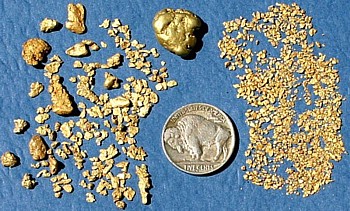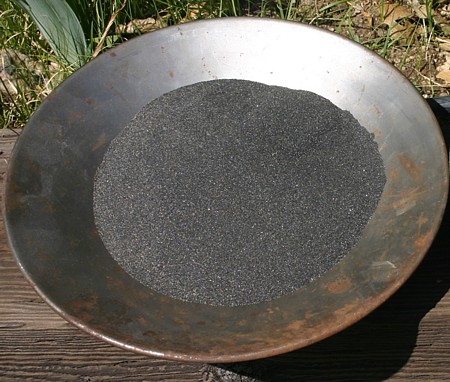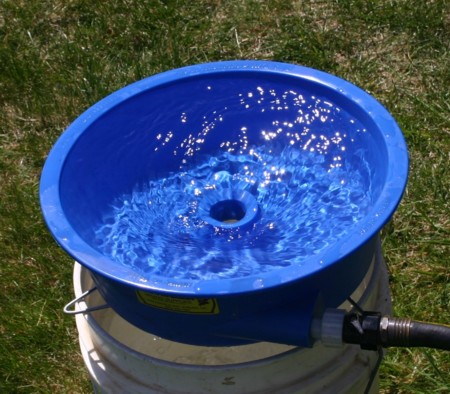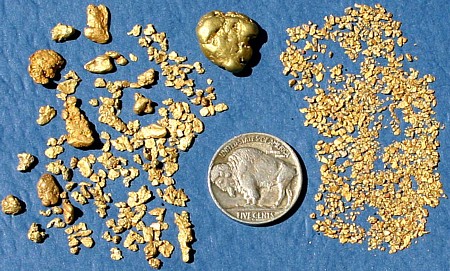Spectacular Photos of Natural Gold

Getting Your Fine Gold Out of Those Black Sands
Every placer miner has to deal with it in one form or another, and some locations have it far worse than others, but nearly every placer has at least some of it: black sand. It collects in our concentrates and gets in the way of recovering our fine gold. Some prospectors worry about getting every speck of gold and save it in buckets until they have tons – others take all the gold they can conveniently remove and then toss out the rest. So what is this mysterious stuff and what should we do about it? Lets take a look at black sands and the best ways to extract all the gold that is reasonable to get, and our options for recovering that gold.The sand, rocks and gravels in the placer deposits we work have a density of about 2.5 to 3. Gold on the other hand, has a density of 19.3 when pure. That difference is what makes all the gravity methods of capturing gold work – whether it’s a simple pan, or a sluice box, dredge, dry washer, table or jig, that big difference in density is what makes working with placers pretty easy. However, these gravity-based methods are not just specific to gold – they capture all the heavy materials in the placer and concentrate them, including black sands. The frustrating thing about black sand is that while it is relatively easy to separate the normal sand and gravel from the gold, it much more difficult to separate the small sized gold from the black sand and other concentrates. There are many methods to accomplish this job – some a lot more efficient than others.

Black sands are heavy, which is why they collect in your pan, dry washer or sluice. They have density of about 5, meaning that those black particles are about 5 times heavier than water. Perhaps the first question about black sands is along the line of “what is this stuff?” Most of black sand is made up of two crystalline oxides of iron: magnetite and hematite. Hematite has a density of 5.3, and magnetite a density of 5.2. Its not surprising that two iron minerals dominate the concentrates, as iron is the fourth most common element in the earth’s crust. Chemically, magnetite has a formula Fe3O4. Its crystalline structure places it in the spinel family of minerals. It melts at 1538 C and has a density of 5.2. It’s structure makes it highly magnetic. Hematite is not so chemically resistant as Magnetite, and its chemical formula is Fe2O3. The little known secret about hematite is that it is actually very slightly magnetic. Nothing like magnetite mind you, and most magnets will not lift it, but it can be picked up with certain extremely strong magnets and we will talk more about that important fact shortly.
In addition to magnetite and hematite, black sands may also contain small amounts of a lot of different heavy minerals depending on the rock types in which you are working. Heavy concentrates may or may not contain at least some of the following: chromite (an ore of chromium), Diamonds, platinum, gold bearing amalgam (lost by early day miners), lead (from fishing weights and bullets), floured mercury, cinnabar (a natural mercury ore), Sheelite (tungsten ore), zircon (a rare gem with a density of 4.7), garnets, pyrite and barite. The proportions that you may find of these minerals or man-made products depend on the specific location where you are prospecting. Some of these things, like diamonds, platinum and amalgam, are valuable in their own right. Mercury and amalgam may contaminate the gold you recover in your sluice box.The amount of black sand and other heavy minerals, which you find associated with your placer gold, varies a lot – there is not a simple direct correlation. There are places that are loaded with black sand but have no gold. Conversely, there are also places that have good quantities of gold but very little black sand.It seems like at least a little black sand is found practically everywhere, so perhaps the next question is “where is all this black sand coming from?” As I noted iron is the fourth most common element in the earth’s crust, so some iron-bearing minerals are found in most rock types. They are especially common in metamorphic and igneous rocks. Since gold deposits are often associated with igneous and metamorphic rocks, it’s easy to see why we nearly always find at least some black sands in our placers. So now that we know a bit about this stuff and where it comes from, what are we supposed to do to get the gold out of it?

First, many new prospectors, believing that it somehow contains large quantities of “hidden” precious metals, find black sand mysterious and incomprehensible. Often this leads to the promotion of expensive and highly questionable treatments to “unlock” the “invisible” values of black sand – including “special” assays, strange leaching techniques, and “magic” fluxes. The truth is that most of the values in black sands are simple free gold particles, which are recoverable by standard gravity recovery methods. Any values truly locked into the black sand, surrounded by minerals such as magnetite so that it cannot be recovered by normal gravity separation systems, are typically very small. The amount of any truly “locked in” gold can be scientifically determined by very meticulously recovering all the free gold possible from a sample of black sand, making sure to carefully examine it under 10x magnification to see that all the free gold has been removed, and then take that clean black sand and run a standard fire assay on it. Do an assay before you invest money in any expensive treatments, because in nearly all cases, this assay will show it is not economically worthwhile to pursue any further treatment of the black sands, especially for the small operator.
Dry washing concentrates are processed in a similar manner, depending on where I am camping. In locations where it is easier to haul all the concentrates around than it is to haul all the water need
ed to process them, I sometimes simply take all my dry wash concentrates home and process them in a tub at the house. The clean black sand and fine gold is added to the black sand fines obtained by dredging, sniping, or sluicing for final processing at the end of the prospecting season.

Getting Your Fine Gold Out of Those Black Sands
Every placer miner has to deal with it in one form or another, and some locations have it far worse than others, but nearly every placer has at least some of it: black sand. It collects in our concentrates and gets in the way of recovering our fine gold. Some prospectors worry about getting every speck of gold and save it in buckets until they have tons – others take all the gold they can conveniently remove and then toss out the rest. So what is this mysterious stuff and what should we do about it? Lets take a look at black sands and the best ways to extract all the gold that is reasonable to get, and our options for recovering that gold.The sand, rocks and gravels in the placer deposits we work have a density of about 2.5 to 3. Gold on the other hand, has a density of 19.3 when pure. That difference is what makes all the gravity methods of capturing gold work – whether it’s a simple pan, or a sluice box, dredge, dry washer, table or jig, that big difference in density is what makes working with placers pretty easy. However, these gravity-based methods are not just specific to gold – they capture all the heavy materials in the placer and concentrate them, including black sands. The frustrating thing about black sand is that while it is relatively easy to separate the normal sand and gravel from the gold, it much more difficult to separate the small sized gold from the black sand and other concentrates. There are many methods to accomplish this job – some a lot more efficient than others.

Black sands are heavy, which is why they collect in your pan, dry washer or sluice. They have density of about 5, meaning that those black particles are about 5 times heavier than water. Perhaps the first question about black sands is along the line of “what is this stuff?” Most of black sand is made up of two crystalline oxides of iron: magnetite and hematite. Hematite has a density of 5.3, and magnetite a density of 5.2. Its not surprising that two iron minerals dominate the concentrates, as iron is the fourth most common element in the earth’s crust. Chemically, magnetite has a formula Fe3O4. Its crystalline structure places it in the spinel family of minerals. It melts at 1538 C and has a density of 5.2. It’s structure makes it highly magnetic. Hematite is not so chemically resistant as Magnetite, and its chemical formula is Fe2O3. The little known secret about hematite is that it is actually very slightly magnetic. Nothing like magnetite mind you, and most magnets will not lift it, but it can be picked up with certain extremely strong magnets and we will talk more about that important fact shortly.
In addition to magnetite and hematite, black sands may also contain small amounts of a lot of different heavy minerals depending on the rock types in which you are working. Heavy concentrates may or may not contain at least some of the following: chromite (an ore of chromium), Diamonds, platinum, gold bearing amalgam (lost by early day miners), lead (from fishing weights and bullets), floured mercury, cinnabar (a natural mercury ore), Sheelite (tungsten ore), zircon (a rare gem with a density of 4.7), garnets, pyrite and barite. The proportions that you may find of these minerals or man-made products depend on the specific location where you are prospecting. Some of these things, like diamonds, platinum and amalgam, are valuable in their own right. Mercury and amalgam may contaminate the gold you recover in your sluice box.The amount of black sand and other heavy minerals, which you find associated with your placer gold, varies a lot – there is not a simple direct correlation. There are places that are loaded with black sand but have no gold. Conversely, there are also places that have good quantities of gold but very little black sand.It seems like at least a little black sand is found practically everywhere, so perhaps the next question is “where is all this black sand coming from?” As I noted iron is the fourth most common element in the earth’s crust, so some iron-bearing minerals are found in most rock types. They are especially common in metamorphic and igneous rocks. Since gold deposits are often associated with igneous and metamorphic rocks, it’s easy to see why we nearly always find at least some black sands in our placers. So now that we know a bit about this stuff and where it comes from, what are we supposed to do to get the gold out of it?

First, many new prospectors, believing that it somehow contains large quantities of “hidden” precious metals, find black sand mysterious and incomprehensible. Often this leads to the promotion of expensive and highly questionable treatments to “unlock” the “invisible” values of black sand – including “special” assays, strange leaching techniques, and “magic” fluxes. The truth is that most of the values in black sands are simple free gold particles, which are recoverable by standard gravity recovery methods. Any values truly locked into the black sand, surrounded by minerals such as magnetite so that it cannot be recovered by normal gravity separation systems, are typically very small. The amount of any truly “locked in” gold can be scientifically determined by very meticulously recovering all the free gold possible from a sample of black sand, making sure to carefully examine it under 10x magnification to see that all the free gold has been removed, and then take that clean black sand and run a standard fire assay on it. Do an assay before you invest money in any expensive treatments, because in nearly all cases, this assay will show it is not economically worthwhile to pursue any further treatment of the black sands, especially for the small operator.
Dry washing concentrates are processed in a similar manner, depending on where I am camping. In locations where it is easier to haul all the concentrates around than it is to haul all the water need
ed to process them, I sometimes simply take all my dry wash concentrates home and process them in a tub at the house. The clean black sand and fine gold is added to the black sand fines obtained by dredging, sniping, or sluicing for final processing at the end of the prospecting season.
At the end of the prospecting year (which for me is late October or early November), I have accumulated something between 20 and 40 pounds of black sand concentrate. In my final clean up, I use a blue bowl hooked up to my garden hose. Careful screening is the key to success with the blue bowl. First I screen the concentrates with a 30 mesh screen. I pan down the coarse matter which is larger than 30 mesh, until there is only a few cups of this material. The minus 30 mesh material is then processed in the blue bowl. Processing this material in the blue bowl is not fast, but it does work. You can relax while you are doing it as not much attention is required once it is set up. I will add about a cup of black sand, then run the bowl for a few minutes, shut down the water flow and add another cup or so, etc. until I have gone through the entire amount of –30 mesh black sand. I do not take the material down to pure gold in the blue bowl, but it does remove the majority of the black sand. At this point, you are left with a cup or so of coarse material you panned down, and about 2 cups of fine gold and black sand.

The next step requires a very strong magnet – you will need one of the new rare earth super magnets, and a good sized one with about 50 pounds or more of pull. Now your normal horseshoe magnet made of iron alloys simply will not do for this. The magnets sold by the most of the major prospecting shops to separate out black sands will not do. Those old style magnets will pick up magnetite, but not hematite. The new powerful rare earth super magnets are necessary because they will pick up the hematite, which is only very slightly magnetic. The old magnets will pick up around half of the black sand, but the super magnets will remove more than 95% of it – and that makes a big difference! These magnets are so strong that you need to be careful – you can get your fingers pinched and smacked as these super powerful magnets attract steel objects from surprising distances and with great speed.
Put the concentrates in a plastic pan with about an inch or two of water – and spread them out into a thin, even layer. Carefully pass the magnet over the black sand from about a half inch above the black sand concentrates. On this first pass, do not touch or stir the concentrates with the magnet. The trick is to make the magnetite and hematite jump up through the water to the magnet leaving the gold behind. Remove the black sand that sticks to the magnet and repeat. Eventually, when nearly all the magnetic minerals are removed, you can stir the magnet through the remaining sand in order to pick up as much of the material as possible. This is the part of the process where you need to examine the material on the magnet very closely as a few particles of gold may be attached to magnetite and stick to the magnet. Repeat the process until no more magnetic minerals can be removed. You can examine the material you removed in the last part of the process with a magnifying glass to see how well you did. Remember a few tiny specs of gold may only be less than a dime’s worth, so there is no great need to worry too much about them. This process is done separately for both the 30+ mesh size and the –30 mesh size. The next step is to dry both fractions separately.

